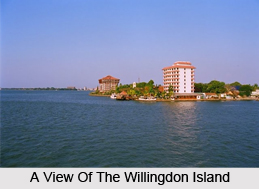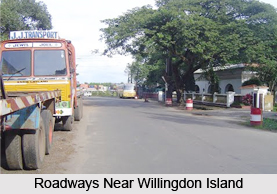 Willingdon Island is significant as the home for the Port of Kochi, as well as the Kochi Naval Base (the Southern Naval Command) of the Indian Navy and Central Institute of Fisheries Technology, a constituent unit of Indian Council of Agricultural Research. The island is also home for other establishments associated with the port, namely, the Office of the Cochin Port Trust (that controls the Port of Kochi), the Customs Office, and more than two dozen export-import offices, warehouses, a few hotels and business centers.
Willingdon Island is significant as the home for the Port of Kochi, as well as the Kochi Naval Base (the Southern Naval Command) of the Indian Navy and Central Institute of Fisheries Technology, a constituent unit of Indian Council of Agricultural Research. The island is also home for other establishments associated with the port, namely, the Office of the Cochin Port Trust (that controls the Port of Kochi), the Customs Office, and more than two dozen export-import offices, warehouses, a few hotels and business centers.
Location of Willingdon Island
Willingdon Island is located in Cochin. Willingdon Island links Kochi with other seaports of the world and houses some of the district`s best hotels, commercial and industrial offices.
History of Willingdon Island
Willington Island was named after the former Viceroy of India, Lord Willingdon. Willingdon Island was connected to the mainland Ernakulam by road-cum-railway Venduruthy Bridge. Robert Bristow, the chief protagonist and engineer for the project, owned the first building on the island. Today the entire land belongs to Cochin Port Trust and Indian Navy.
As per the project draft, a basic port structure was completed by 1939, just prior the Second World War. A deep wharf, a rail bridge and a road bridge connecting to the mainland were made to provide valuable infrastructure for the local war effort. A naval works was also built on the adjacent Venduruthy Island. When the time war ended, those working on island project got busy constructing landing craft for the presumed invasion of Japan.
The other buildings constructed nearby include a passenger platform and rail siding. This huge expanse of virgin territory was soon procured by the Royal Air Force, which constructed a large aerodrome there. This man-made isle near Cochin City, thus, became a thriving military base. The Malabar Hotel served in providing quarters to all wartime staff and soon this building was joined by a new administrative block next door. A new post office, a swanky open-air swimming bath and an adjoining bank completed the facilities.
When the British withdrew from India after independence in 1947, they left behind an indispensable and significant transport hub. During its short colonial tenure, the Willingdon Island in Cochin handled almost one million tons of freight and by the year 1960, the traffic had almost doubled. It is a major artificial port in India and serves as a major landmark in the Kochi city of Kerala. The Willingdon Island also serves as a link between the city and some other seaports of the world.
How to Reach Willingdon Island
Willingdon Island is connected to the mainland by the road and railway Venduruthy Bridge. The headquarters of the southern naval command of the Indian Navy is located at this charming island. Cochin shipyard is also located near this island.
One could reach Willingdon Island through rail by getting down at the cochin Railway station and then catching a bus to Willingdon island. The distance from cochin station to Willingdon island is 11 km.
Willingdon Island is connected to Kochi"s mainland by road and the railway Venduruthy Bridge.Kochi is well connected by road from all parts of the state as well as other major cities. To reach Willingdon Island you can either take the road journey or you can go by ferries. Ferries here run at regular interval.
This is a peaceful place (far from the maddening crowd of Ernakulam town). There are not many vehicles on the road and one can walk peacefully on the roadside.
This beautiful island was made by expanding a small natural island during the colonial era. It is a good place to stay while on a vacation to Kochi. It is also a major tourist center. Willingdon Island today plays an important role in the city of Kochi and houses some of the district`s best hotels, commercial and industrial offices.



















